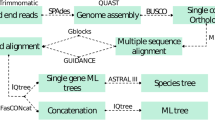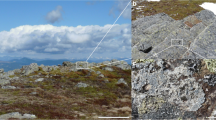Abstract
As part of a worldwide sampling nine black fungi were isolated from rocks collected in four distinct sites of the Alps at high altitudes. Based on a nucSSU, nucLSU and mtSSU multi-locus phylogeny, seven of them were found to cluster into a distinct and well-supported clade in a basal position within the Class Dothideomycetes. As in other rock fungi these new groups of isolates were characterized by a meristematic growth and a scarcely differentiated morphology with highly melanized and thick-walled toruloid hyphae. Nonetheless, few peculiar characters were also observed as convoluted hyphal tips and the production of spherical propagules. The new genus and species Saxomyces alpinus and S. penninicus, are here described based on morphological and molecular data, in a yet to be defined order of the Dothideomycetes. The remaining two black fungi clustered in Cryomyces, a genus previously exclusively found in rocks from the McMurdo Dry Valleys in Antarctica. These two isolates were genetically distant from other Antarctic Cryomyces species based on ITS sequences, and they showed a peculiar morphology; they are here described as the new species C. montanus and C. funiculosus. Implications of our results on the evolution, adaptation and dispersal of rock-inhabiting fungi under extreme conditions are discussed.








Similar content being viewed by others
References
Arenz BE, Held BW, Jurgens JA, Blanchette RA (2011) Fungal colonization of exotic substrates in Antarctica. Fungal Diversity 49:13–22
De Hoog GS (1999) Ecology and evolution of black yeasts and their relatives. In: de Hoog GS (ed) Studies in Mycology. Centraalbureau voor Shimmelcultures, Baarn, p 208
Dadachova E, Casadevall A (2008) Ionizing radiation: how fungi cope, adapt, and exploit with the help of melanin. Curr Opin Microbiol 11:525–531
De Leo F, Urzì C, de Hoog GS (2003) A new meristematic fungus, Pseudotaeniolina globosa. Antonie van Leeuwenhoek 83:351–360
Diakumaku E, Gorbushina AA, Krumbein WE, Panina L, Soukharjeski S (1995) Black fungi in marble and limestones – an aesthetical, chemical and physical problem for the conservation of monuments. Sci Total Environ 167:295–304
Felsenstein J (1985) Confidence limits on phylogenies: an approach using the bootstrap. Evolution 40:783–791
Friedmann EI (1982) Endolithic microorganisms in the Antarctic Cold Desert. Science 215:1045–1053
Gorbushina AA, Krumbein WE, Hamman CH, Panina L, Soukharjevski S, Wollensien U (1993) Role of black fungi in color-change and biodeterioration of antique marbles. Geomicrobiol J 11:205–221
Gorbushina AA, Panina LK, Vlasov DY, Krumbein WE (1996) Fungi deteriorating Chersonessus marbles. Mycologia i Fitopatologija 30:23–28
Gorbushina AA (2002) Microcolonial fungi: survival potential of terrestrial vegetative structures. Astrobiology 3:543–554
Gorbushina AA (2003) Methodologies and techniques for detecting extraterrestrial (microbial) life. Microcolonial fungi: Survival potential of terrestrial vegetative structures. Astrobiology 3:543–554
Gorbushina AA (2007) Life on the rocks. Environ Microbiol 9:1613–1631
Gorbushina AA, Whitehead K, Dornieden T, Niesse A, Schulte A, Hedges JI (2003) Black fungal colonies as units of survival: Hyphal mycosporines synthesized by rock-dwelling microcolonial fungi. Can J Bot 81:131–138
Gorbushina AA, Kort R, Schulte A, Lazarus D, Schnetger B, Brumsack HJ, Broughton WJ, Favet J (2007) Life in Darwin’s dust: Inter-continental transport and survival of microbes in the nineteenth century. Environ Microbiol 9:2911–2922
Gorbushina AA, Kotlova ER, Sherstneva OA (2008) Cellular responses of microcolonial rock fungi to long-term desiccation and subsequent rehydration. Stud Mycol 61:91–97
Guindon S, Gascuel O (2003) A simple, fast, and accurate algorithm to estimate large phylogenies by maximum likelihood. Syst Biol 52:696–704
Jobb GA, Von Haeseler A, Strimmer K (2004) Treefinder: A powerful graphical analysis environment for molecular phylogenetics. BMC Evol Biol 4:18
Marvasi M, Donnarumma F, Frandi A, Mastromei G, Sterflinger K, Tiano P, Perito B (2012) Black microcolonial fungi as deteriogens of two famous marble statues in Florence, Italy. Int Biodeterior Biodegrad 68:36–44
Nienow JA, Friedmann EI (1993) Terrestrial litophytic (rock) communities. In: Friedmann EI (ed) Antarctic Microbiology. Wiley-Liss, New York, pp 343–412
Nylander JAA. 2004. Mr Aic.pl. Programme distributed by the author. Evolutionary Biology Centre, Uppsala University.
Onofri S, Pagano S, Zucconi L, Tosi S (1999) Friedmanniomyces endolithicus (Fungi, Hyphomycetes) anam. gen. sp. nov., from continental Antarctica. Nova Hedwigia 68:175–181
Onofri S, Selbmann L, de Hoog GS, Grube M, Barreca D, Ruisi S, Zucconi L (2007) Evolution and adaptation of fungi at the boundaries of life. Advances in Space Research 40:1657–1664
Onofri S, Barreca D, Selbmann L, Isola D, Rabbow E, Horneck G, de Vera JPP, Hatton J, Zucconi L (2008) Resistance of Antarctic black fungi and cryptoendolithic communities to simulated space and Martian conditions. Stud Mycol 61:99–109
Onofri S, de la Torre R, de Vera JP, Ott S, Zucconi L, Selbmann L, Scalzi G, Venkateswaran K, Rabbow E, Horneck G (2012) Survival of rock-colonizing organisms after 1.5 years in outer space. Astrobiology 12:508–516
Palmer FE, Staley JT, Ryan B (1990) Ecophysiology of microcolonial fungi and lichens on rocks in Northeastern Oregon. New Phytol 116:613–620
Page RDM (1996) Treeview: An application to display phylogenetic trees on personal computers. Bioinformatics 12:357–358
Pearce DA, Bridge PD, Hughes KA, Sattler B, Psenner R, Russel NJ (2009) Microorganisms in the atmosphere over Antarctica. FEMS Microbiol Ecol 69:143–157
Ruibal C (2004) Isolation and characterization of melanized, slow-growing fungi from semiarid rock surfaces of central Spain and Mallorca. Ph.D. dissertation. Universidad Autónoma de Madrid/Merck, Sharp & Dohme de España, Madrid
Ruibal C, Gonzalo P, Bills GF (2005) Isolation and characterization of melanized fungi from limestone formations in Mallorca. Mycol Prog 4:23–38
Ruibal C, Platas G, Bills GF (2008) High diversity and morphological convergence among melanised fungi from rock formations in the Central Mountain System of Spain. Persoonia 21:93–110
Ruibal C, Gueidan C, Selbmann L, Gorbushina AA, Crous PW, Groenewald JZ, Muggia L, Grube M, Isola D, Schoch CL, Staley JT, Lutzoni F, De Hoog GS (2009) Phylogeny of rock-inhabiting fungi related to Dothideomycetes. Stud Mycol 64:123–133
Sanger F, Nicklen S, Coulson AR (1977) DNA sequencing with chain-terminating inhibitors. PNAS 74:5463–5467
Schoch CL, Shoemaker RA, Seifert KA, Hambleton S, Spatafora JW, Crous PW (2006) A multigene phylogeny of the Dothideomycetes using four nuclear loci. Mycologia 98:1041–1052
Schoch CL, Crous PW, Groenewald JZS, Boehm EWA, BurgessTI GJ, De HGS, De DLJ, Grube M, Gueidan C, Harada Y, Hatakeyama S, Hirayama K, Hosoya T, Huhndorf SM, Hyde KD, Jones EBG, Kohlmeyer J, Kruys Å, Li YM, Lücking R, Lumbsch HT, Marvanová L, Mbatchou JS, McVay AH, Miller AN, Mugambi GK, Muggia L, Nelsen MP, Nelson P, Owensby CA, Phillips AJL, Phongpaichit S, Pointing SB, Pujade-Renaud V, Raja HA, Rivas Plata E, Robbertse B, Ruibal C, Sakayaroj J, Sano T, Selbmann L, Shearer CA, Shirouzu T, Slippers B, Suetrong S, Tanaka K, Volkmann-Kohlmeyer B, Wingfield MJ, Wood AR, Woudenberg JHC, Yonezawa H, Zhang Y, Spatafora JW (2009) A class-wide phylogenetic assessment of Dothideomycetes. Stud Mycol 64:1–15
Selbmann L, De Hoog GS, Mazzaglia A, Friedmann EI, Onofri S (2005) Fungi at the edge of life: Cryptoendolithic black fungi from Antarctic desert. Stud Mycol 51:1–32
Selbmann L, De Hoog GS, Gerrits Van Den Ende AHG, Ruibal C, De Leo F, Zucconi L, Isola D, Ruisi S, Onofri S (2008) Drought meets acid: Three new genera in a Dothidealean clade of extremotolerant fungi. Stud Mycol 61:1–20
Selbmann L, Isola D, Zucconi L, Onofri S (2011) Resistance to UV-B induced DNA damage in extreme-tolerant cryptoendolithic Antarctic fungi: Detection by PCR assays. Fungal Biology 115:937–944
Sert HB, Sümbül H, Sterflinger K (2007a) Microcolonial fungi from antique marbles in Perge/Side/Termessos (Antalya/Turkey). Antonie van Leeuwenhoek 91:217–227
Sert HB, Sümbül H, Sterflinger K (2007b) Sarcinomyces sideticae, a new black yeast from historical marble monuments in Side (Antalya, Turkey). Bot J Linn Soc 154:373–380
Sert HB, Sümbül H, Sterflinger K (2007c) A new species of Capnobotryella from monument surfaces. Mycol Res 111:1235–1241
Staley JT, Palmer F, Adams JB (1982) Microcolonial fungi: Common inhabitants on desert rocks? Science 215:1093–1095
Sterflinger K, de Baere R, de Hoog GS, de Watcher R, Krumbein WE, Haase G (1997) Coniosporium perforans and C. apollinis, two new rock-inhabiting fungi isolated from marble in the Sanctuary of Delos (Cyclades, Greece). Antonie van Leeuwenhoek 72:349–363
Sterflinger K (1998) Temperature e NaCl- tolerance of rock-inhabiting meristematic fungi. Antonie van Leeuwenhoek 74:271–281
Sterflinger K (2006) Black yeast and meristematic fungi: ecology, diversity and identification. In: Péter G, Rosa C (eds) The yeast handbook. Biodiversity and ecophysiology of yeasts. Springer, Berlin, pp 501–514
Tamura K, Dudley J, Nei M, Kumar S (2007) MEGA4: Molecular evolutionary genetics analysis (MEGA) software version 4.0. Mol Biol Evol 24:1596–1599
Thompson JD, Gibson TJ, Plewniak F, Jeanmougin F, Higgins DG (1997) The ClustalX windows interface: Flexible strategies for multiple sequence alignment aided by quality analysis tools. Nucleic Acids Res 24:4876–4882
Tsuneda A, Hambleton S, Currah RS (2011) The anamorph genus Knufia and its phylogenetically allied species in Coniosporium, Sarcinomyces, and Phaeococcomyces. Botany 89:523–536
Van Uden N (1984) Temperature profiles of yeasts. Advances in Microbiological Physiolology 25:195–251
Vilgalys R, Hester M (1990) Rapid genetic identification and mapping of enzymatically amplified ribosomal DNA from several Cryptococcus species. J Bacteriol 172:4238–4246
Vincent W (2000) Evolutionary origins of Antarctic mycobiota: invasion, selection and endemism. Antarct Sci 12:374–385
Vishniac HS (1987) Psychrophily and systematics of yeast-like fungi. In: Hoog GS de, Smith MTh, Weijman ACM, (eds), The expanding Realm of Yeast-like Fungi. Studies in Mycology 30: 389–402
White TJ, Bruns T, Lee SB, Taylor JW (1990) Amplification and direct sequencing of fungal ribosomal RNA genes for Phylogenetics. In: Innis MA, Gelfand DH, Sninsky JJ, White TJ (eds) PCR Protocols, A guide to methods and applications. Academic, San Diego, pp 315–322
Volkmann M, Gorbushina AA (2006) A broadly applicable method for extraction and characterisation of mycosporines and mycosporine-like amino acids of terrestrial, marine and freshwater origin. FEMS Microbiol Lett 255:286–295
Wollenzien U, de Hoog GS, Krumbein WE, Urzì C (1995) On the isolation of microcolonial fungi occurring on and in marble and other calcareous rocks. Sci Total Environ 167:287–294
Wollenzien U, de Hoog GS, Krumbein WE, Uijthof JMJ (1997) Sarcinomyces petricola, a new microcolonial fungus from marble in the Mediterranean basin. Antonie van Leeuwenhoek 71:281–288
Zoller S, Scheidegger C, Sperisen C (1999) PCR primers for the amplification of mitochondrial small subunit ribosomal DNA of lichen-forming ascomycetes. Lichenologist 31:511–516
Zucconi L, Gagliardi M, Isola D, Onofri S, Andaloro MC, Pelosi C, Pogliani P, Selbmann L (2012) Biodeteriorigenous agents dwelling the wall paintings of the Holy Saviour’s Cave (Vallerano, Italy). Int Biodeterior Biodegrad 70:40–46
Acknowledgements
MIUR-PRIN 2008 (prot. 2008AR8MX9) is gratefully acknowledged for financial support. The authors thank the PNRA (Italian National Program for Antarctic Research) and the Italian National Antarctic Museum “Felice Ippolito” for funding CCFEE (Culture Collection of Fungi From Extreme Environments). The Alpine guide A. Serafini is kindly acknowledged for collecting rock samples from the Alps.
Author information
Authors and Affiliations
Corresponding author
Rights and permissions
About this article
Cite this article
Selbmann, L., Isola, D., Egidi, E. et al. Mountain tips as reservoirs for new rock-fungal entities: Saxomyces gen. nov. and four new species from the Alps. Fungal Diversity 65, 167–182 (2014). https://doi.org/10.1007/s13225-013-0234-9
Received:
Accepted:
Published:
Issue Date:
DOI: https://doi.org/10.1007/s13225-013-0234-9




